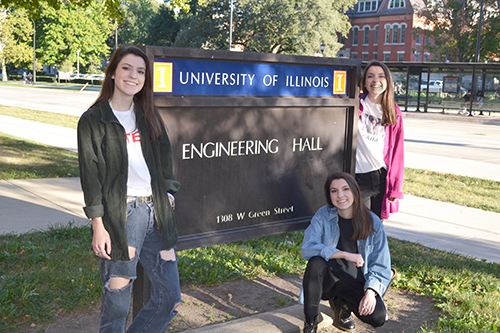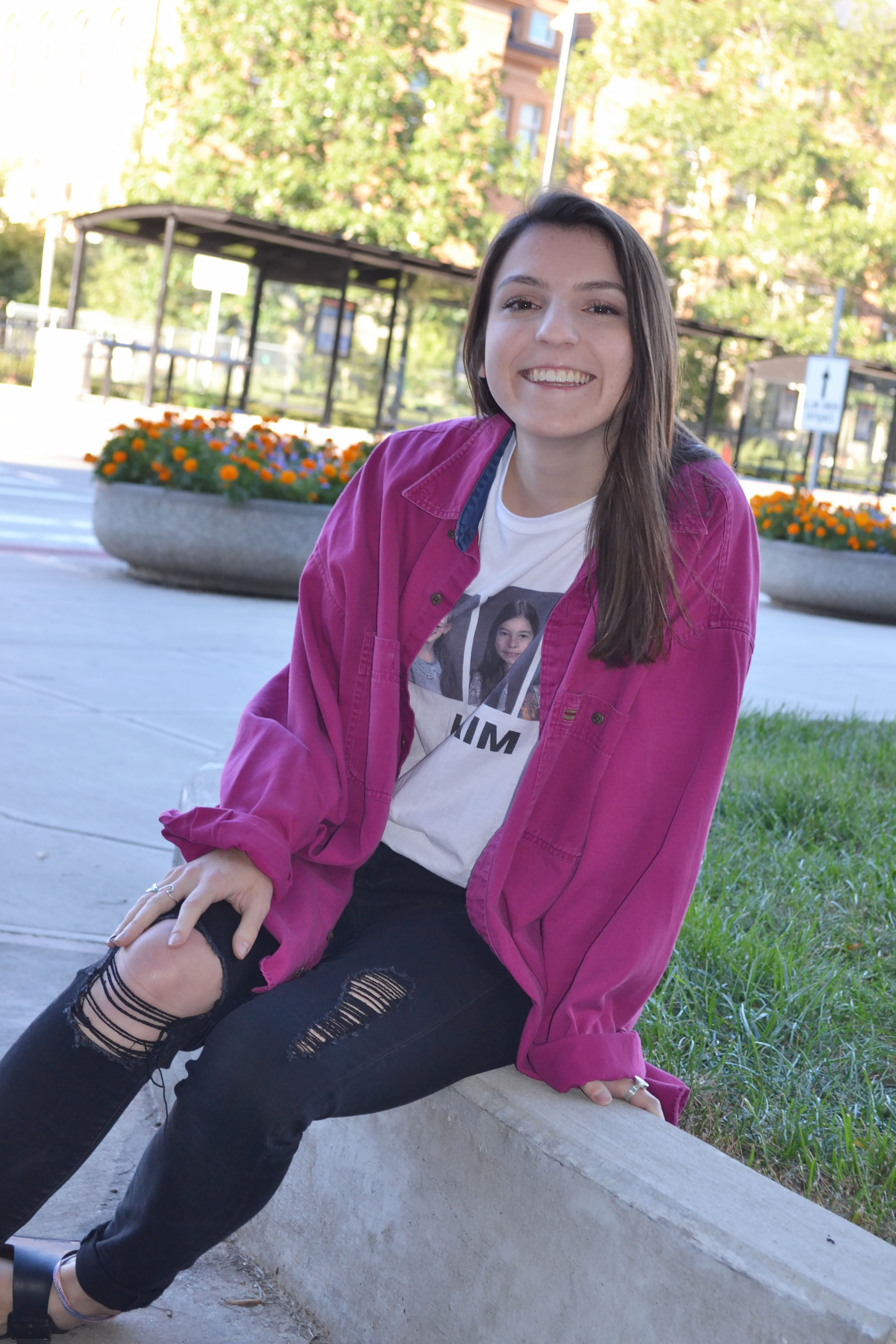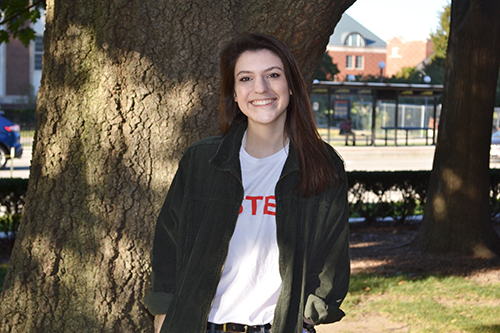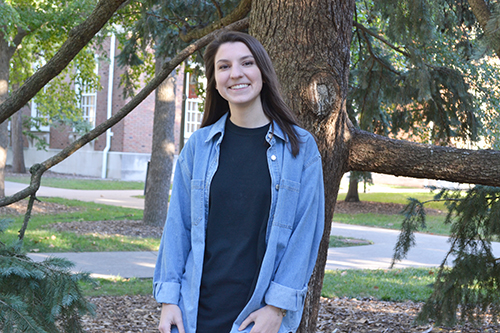Becoming Engineers at Illinois Triple the Fun for the Ponicki Sisters

(right to left) Mary, Theresa, and Frances in front of the Engineering Hall sign.
September 26, 2018
When identical triplets Frances, Mary, and Theresa Ponicki were growing up, there wasn’t a huge push to get girls interested in STEM. But the three, currently seniors in the Systems Engineering and Design (SED) program in Industrial and Enterprise Systems Engineering (ISE) loved playing with Legos. Mind you, these weren’t the dumbed-down pink ones the toy manufacturer currently makes for girls, assuming they can’t handle the same kind of stuff boys can. This Lego kit was a hand-me-down from their older sister who had been interested in industrial design before switching to education— complete with gears that encouraged them to design and build machines. Frances claims that playing with Legos “kind of got us into STEM without us really even realizing it.” “We're really focused on design,” adds Theresa, “so it kind of runs in the family.”
In fact, growing up, they weren’t even exposed to STEM outreach events. (They were chess club nerds.) Not only was STEM not being encouraged, but they say that a lot of their high school teachers weren't pro women in STEM at the time. "There weren't outreaches,” Frances admits, “it was more like us reaching out and pushing through.”
So, despite a less-than-supportive school climate, they recognized what they liked in the math and science field and "kind of took that and ran with it,” Mary adds. Despite the fact that their teachers “weren't always super encouraging of it, we were really excited about it, and that's what made the difference.”
Plus, they had something other girls in similar discouraging situations might not have had—each other. Sort of like the Three Musketeers (actually four, including their best friend Jess), they had each other’s backs; they took all the same math and science courses and, ironically, never really noticed that they were the only girls.

Frances Ponicki
“When we were in those classes, I never really noticed the gender gap,” says Mary. “Now, thinking back on it, there was a serious gap between the number of females and the number of males in the classes, but it never really came to my attention until recently.” Because her siblings were there with her, and because of their support, she’s never had to say, “I'm the only female in here,” she continues. “Who am I going to do my homework with?" They had a ready-made study group that has lasted even to this day.
How did they all end up at Illinois, studying engineering together? Probably because Mom and Dad were Illinois alums, right? Nope. “That's a good question, because we definitely did not think we were going to go here at all,” Frances acknowledges.
The Ponicki triplets grew up just a few miles north of Champaign-Urbana on I57, in Arlington Heights, a suburb northwest of Chicago, so the proximity of a world-class university was always in the back of their parents’ minds. “Both of our parents went here,” says Frances, “so I would definitely say it was pushed from the get-go.”
However, for the girls, not only was Illinois not in the running initially, but Engineering wasn’t even an option at that point. “We were all over the board with what we wanted to do when we were looking at different university programs in high school,” admits Mary. Some of their options were physical therapy, pre-vet, even horticulture; plus, they had taken and enjoyed a woodshop class and a CAD class. “We had no idea,” Mary admits, “but the thing that we all kept coming back to, and the thing that our parents kept reminding us of, was that we were excelling, and that we really enjoyed our math and science classes.”
The thing that clinched it for them regarding Illinois was the SED degree program’s option where in the third and fourth year of their program, students can declare a secondary field and focus on whatever specialization they want.

Mary Ponicki
According to Mary, when they visited SED, the advisor told them, “You can do anything,” then described a former student who had been interested in prosthetics and how the body worked, so he specialized in dance and took dance classes to understand that. The girls were told, “If you're interested in something, and you can make a case for it, then you can pave your own way through the major.’ We were really into that, because we really wanted to combine a more creative side of engineering with the degree, and that's why we all ended up here in that specific major.”
Ironically, although they had looked at a number of majors at different schools, and toured numerous universities, all on the east coast, they never once toured Illinois. “I think we applied to U of I a week before the application was due,” Frances admits. “It was super last minute. We wanted to make this decision by ourselves!”
Now that they’re here, is there always a reaction when the three of them walk into a class together? Not usually. They’re known throughout ISE, which is a smaller department. Plus, now that they’re seniors, their classes are specialized, so they're with the same people every semester. However, when they walked in to Mechanical Engineering’s ME270, Design for Manufacturability lecture for the first time in fall 2018, it caused a bit of a stir. “Professor Liebenberg was super nice about it, super great about it,” says Frances. “We haven't gotten that reaction in a while because we're in our senior year.”
Regarding having the triplets in his lecture, Liebenberg admits that he’s struggled a bit in terms of knowing who’s who. “They always sit next to each other; they always answer questions in class; and I never know who they are. It’s quite hilarious.”
Vis-à-vis not being able to tell the girls apart, we’ve all heard stories about twins or triplets pulling a switcheroo and posing as each other. Did the Ponicki sisters ever say, “Ok, you bone up on the history and take the test for all of us; you cover chemistry, and I’ll cover the math”?
They recall trying to switch once in their freshman year of high school, when they all had the same classes but at different times. However, the first time they tried it, the one teacher in high school who could tell them apart noticed and had a heart-to-heart with them. “He wasn't mad,” Frances admits. “He thought it was great. But we talked about how we shouldn't do it for exams, which we knew. Going forward, we wouldn't want to do it for exams anyway, because we were all trying to get into a good university, and so if you only know one subject, then you got to university saying you knew it, it'd be harder.”
What about for a date? Have the three of them ever substituted for one of their siblings? They didn’t even try; their friends are too smart. “If you're friends with my sisters and I, you can tell us apart,” admits Frances.
In fact, their friends might even be better at noticing their differences, personality-wise, than the girls themselves. Frances shares an anecdote: “We were over at my friend's house on campus the other night, and she was doing imitations of the three of us in the same scenario—our friends are very good about picking out our personalities, but I never know how to.”
“We do have different personalities, but it's hard for us to pinpoint what exactly it is unless it's situational,” agrees Mary. “Like I could say, ‘Teresa would do this; Fran would do this, and I'd do this,’ but for personality traits, we have a little bit of everything.”
Do the sisters ever finish each other’s sentences? Mary believes they “think along very similar wavelengths.” For instance, they’ll be driving and see a sign that reminds them of something. One will say, "Remember when…?" and another will say, "I was just going to say that," and that's all they have to say to understand what they’re talking about. Also, when they’re telling stories, they just naturally jump in to tell “their” part of the story without even communicating.

Theresa Ponicki
“My sisters and I take a lot of the courses together," Frances continues, "so it's never really in the forefront of my mind that there aren't any women in here, because I have my sisters, and that's really all I need.”
Theresa shares an anecdote about when the three of them studied abroad in Australia. “It was so weird,” she exclaims, then shares how she and Mary had gone two weeks early and were sharing a story with a guy they’d just met: “I was telling it,” Theresa says, “and then Mary transitions in really smoothly. And then it gets silent, so Mary and I kind of look at each other and immediately, it was like, ‘This is where Fran would fill in.’ We looked at each other, and we were like, ‘Whoah!’" They had just then realized how much they take turns telling a story until one of them was missing.
In addition to study abroad, the Ponickis’ careers at Illinois have been well rounded. They’ve taken advantage of several RSOs (Registered Student Organizations) and other opportunities on campus. For example, the summer before their freshman year, they took classes on campus through Engineering’s Summer Scholars program. They also did WIE Orientation, and report that some of the girls they met there, especially those in ISE, are still some of their closest friends. “We do all of our homework together, and we talk all the time,” Frances says. “It's been one big journey from start to finish together. We wouldn't have ever met them if we hadn't gone to that.” The RSO they’ve mostly been involved in is Catholic Illini through Newman Hall, where they serve as ambassadors and help plan events. In addition to doing events with Engineering Without Borders and Women in Engineering (WIE), they’ve also been heavily involved in ISE, working to help recruit future students.
Also, because STEM outreach was noticeably absent when they were younger, they’ve been involved with outreach hoping to get younger students, especially women, interested in STEM. Towards the end of their internship this past summer, they joined the board of STEAM Ahead, an organization promoting women-in-STEAM efforts in the Naperville area, helping plan an upcoming event called STEAM Fest. It will offer activities designed to pique college and high-school-aged women’s interest in the different STEAM fields, as well as foster networking and mentorship.
Having been involved in mostly the same opportunities, the same major, and mostly the same courses, are the girls thinking about the same career? Pretty much.
The sisters all have the same concentration in Systems Engineering and Design: digital prototyping. Huge fans of Autodesk software, they specifically want to work with computer-aided design (CAD). Theresa’s dream job is “to be pushing the envelope, developing new technology, developing new designs, being on the forefront of technology.”
In preparation for their CAD careers, they haven’t really taken a lot of coding classes; their curriculum involved one computer science course their freshman year. “It's more you learn as you go,” Theresa explains. “You learn MatLab, different software, but there weren't any specific courses on that. It was more of computer-aided design incorporated into the curriculum.”
For example, they’re particularly enjoying Professor Leon Liebenberg’s ME270 course, which is required as part of their Digital Prototyping concentration. “Design with intent, that's a huge thing,” Theresa explains. “When you go to manufacture something, you want to design it so that it's easy to manufacture, it's easy to produce. This is a huge class that focuses on that and the ways that you can produce a product.”
Of course, what particularly intrigues them about the course is that in the lab section, they’re using CAD software to design things. “We're really excited to see where that all goes,” Mary says. “CAD is a big part of the manufacturing world right now. It's really coming together head on. That's really exciting for us, because that's what we're really passionate about. (We could talk about it probably for hours!)”

(left to right) Mary, Theresa, and Frances Ponicki.
On a more personal level, what they also love about ME 270 is that they actually get to be together. Although they live together, according to Frances, “It’s like the only 2 hours out of the week where we get to see each other consistently!”
“The interesting thing about this semester,” complains Frances, “because we're in senior design and so many other project-based courses, we rarely see each other. This is the first semester that, even though we're in the same courses, we don't see each other very often. Because we're all in different project groups and it's a minimum of 15–20 hours a week for senior design.”
For their senior design course, SE494, Professor Wildblood arranged projects with different companies, which give them optimization and design projects and a budget. Projects are assigned based on students’ background, concentration, and preference. For instance, Frances is working with Harger Lightning and Grounding Corporation. “We're all on a different design project,” Frances says. “I love mine. We're all really happy with them.”
Also, because it's their senior year, the three have been frequently discussing their immediate future. Grad school is on the table, as is getting jobs once they graduate. Also, they’re not opposed to working for the same company. For example, they all did internships at Nokia in Naperville this past summer. “It was really fun to be working together,” Mary acknowledges. “The project was fun. It was a field we all wanted to be in. Because we're all interested in the same thing, none of us are against working at the same company. That doesn't mean we're seeking it out,” she qualifies, “we're just taking it as it comes.”
Despite having chosen Illinois at the last minute, the girls all say attending Illinois has been quite meaningful for them. For instance, Frances calls it “one giant open door of opportunities.”
>“Every year,” she continues, “Every semester has a very defining class that made it easy, hard, or memorable. The friends that I made and the job opportunities that I had would not have been possible without U of I, and definitely not without ISE, our department. I feel very well-developed. I'm really happy with where I am.”
“I was looking at my resume the other day,” Mary chimes in, “and I was like, ‘This is great!’ I really feel like I've gotten to do the things I wanted to do at U of I. It's been really phenomenal! I know I speak for my sisters on this when I say it as well—we're all super grateful that we came to this school. From the professors we've had, to the friendships we've made, the opportunities that we were provided. We haven't really had a professor that we didn't like.”
She also appreciates the multi-disciplinary emphasis of their program. “I feel like we've been able to connect with a lot of the professors on campus, and I feel like I have roots in different departments on campus. It just provided so many different opportunities for us professionally, and it's been a really great way to grow and develop over the last four years. We're all really happy here. We're really happy with what it has provided us and the future it set us up for.”
Theresa reiterates that another thing that’s been really special for her and her sisters is that they were able to do it together. “We were all able to carve our own paths at Illinois, but we were able to have each other in each other’s corners the entire time. A lot of my favorite memories at Illinois have been with my sisters. A lot of the things that we have done together have been special and really defining in my career, and the choices I've made, and the friendships I've developed. It's been really awesome to have my sisters here, because we did consider going to different universities, and we applied to different universities, but we ended up here together and that was the right decision in the end.”
Frances recalls being a freshman and doubting that she could be successful. Now, looking back at all they’ve accomplished, she says, “That's such a testimony to being an overwhelmed freshman talking to our engineering learning assistant. He was very successful and doing a lot of cool things, so it was like ‘Wow, how am I ever going to get there?’ Now, as a senior on the cusp, she would love to go back and encourage her “freshman year self and be like, ‘Hey, you can do this! You're going to do amazing things! There's going to come a time..’ I'm where I want to be,” she acknowledges, “and I had two amazing partners to do it with. I'm really happy with just going to U of I. It's been amazing!”
Story and photos by Elizabeth Innes, Communications Specialist, I-STEM Education Initiative, unless noted otherwise.
For more related stories, see: Illinois Legacies, Student Spotlight, WIE, Women in STEM, 2018

(left to right) Frances, Theresa, and Mary Ponicki in front of the Alma Mater.













.jpg)
















